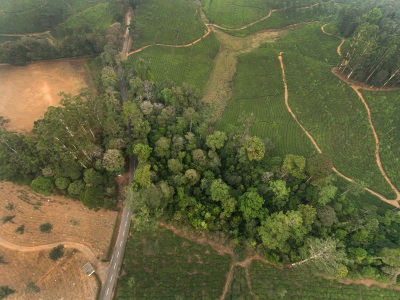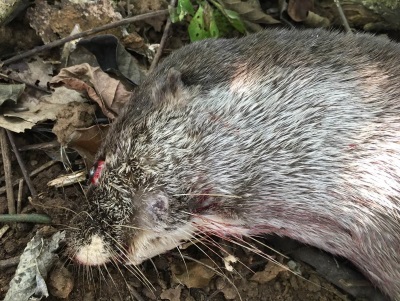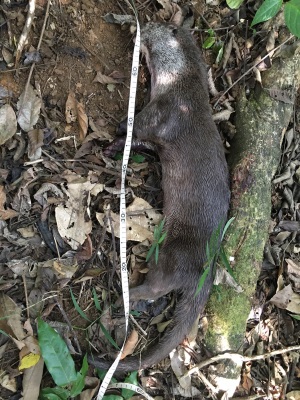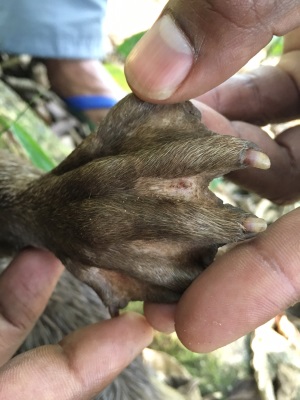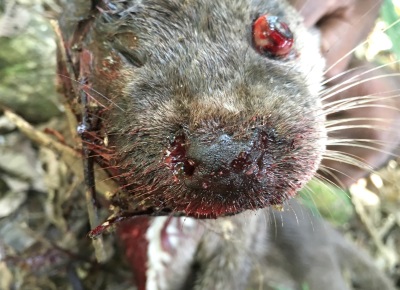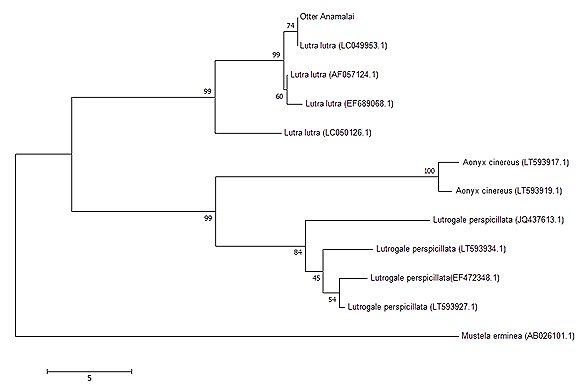IUCN/SSC Otter Specialist Group Bulletin

©IUCN/SCC Otter Specialist Group
Volume 35 Issue 1 (January 2018)
Citation: Mudappa, D, Prakash, N, Pawar, P, Srinivasan, K, Ram, MS, Kittur, S and Umapathy, G (2018). First Record of Eurasian Otter Lutra lutra in the Anamalai Hills, Southern Western Ghats, India. IUCN Otter Spec. Group Bull. 35 (1): 47 - 56
First Record of Eurasian Otter Lutra lutra in the Anamalai Hills, Southern Western Ghats, India
Divya Mudappa1*, Nisarg Prakash1, Pooja Pawar1, K. Srinivasan1, M. S. Ram2, Sagar Kittur2, And G. Umapathy2
1Nature Conservation Foundation, 3076/5, IV Cross, Gokulam Park, Mysore 570002, India. e-mail: divya@ncf-india.org
2 Laboratory for the Conservation of Endangered Species, CSIR-Centre for Cellular and Molecular Biology, Hyderabad 500007, India
| (Received 9th July 2017, accepted 5th November 2017) |
| Download PDF (2.4 MB) |
| Abstract: There have been historic records of Eurasian otters from the Western Ghats biodiversity hotspot, but no evidence in the intervening seven decades. This had led to some doubt regarding the veracity of earlier records or attributed them to mislabelling of specimens. However, with the recent discovery of a roadkill of a Eurasian otter and following confirmation of identity of species from both photographs and molecular analysis, the occurrence of the species in the Anamalai hills of southern Western Ghats is confirmed. In this note, we present data from this first photographic and molecular evidence of the Eurasian otter from the southern Western Ghats. Morphometric measurements recorded helped identify the species and tissue sample analyzed showed 97–100% identity with Lutra lutra sequences available in the GenBank database. Records based on sightings or signs without photographic or molecular evidence should be treated with caution given the difficulty in identifying otters in field. |
| Keywords: Plantations, roadkill, molecular genetics, otter distribution |
| Française | Español |
INTRODUCTION
South Asia is home to three species of otters namely Smooth-coated otter Lutrogale perspicillata, Eurasian otter Lutra lutra, and Oriental small-clawed otter Aonyx cinereus (Hussain, 1999). In the Western Ghats mountain range along the west coast of southern India, there have been a number of recent sighting records and observations of smooth-coated and small-clawed otters but no record, validated by photographs or genetic studies, of the Eurasian otter. Eurasian otters have been historically reported from the hills of Coorg in Karnataka state, and the Nilgiris and Palni hills of Tamil Nadu state in the Western Ghats (Pocock, 1941; Prater 1980), but there have been no records for over seven decades in this region, validated by either photographs or genetic material. Based on specimens collected during the mammal survey of India (1911 – 1923), Pocock (1941) noted that the species occurs along the Himalaya from Kashmir to Sikkim extending into the Gangetic region, with no confirmed records in the intervening region till southern India. However, recent records of Eurasian otters have emerged from camera trap images in forests of central India (Joshi et al., 2016, Vaibhav Chaturvedi, pers comm). Additionally, there have also been recent images of Eurasian otters caught on camera traps in the trans-Himlayan region of Ladakh (Melissa Savage, pers. comm) and the Sikkim Himalayas (Sunita Khatiwara, pers. comm). Here, we report a record of Eurasian otter found as a road-kill in 2016 in the Anamalai hills, Tamil Nadu, Western Ghats.
Smooth-coated otters have been often seen in reservoirs and large rivers, while the small-clawed otters have been observed mostly in hill streams in altitudes above 500 m. The Eurasian otter is also expected to occur in hill streams (Pocock, 1941). Surveys by Raha and Hussain (2015) in five protected areas in the southern Western Ghats assessed habitat use of all the three species largely based on spraints and tracks. They have reported only the small-clawed otter for the Anamalai and Parambikulam Tiger Reserves. The Eurasian otter is reported from Periyar Tiger Reserve based on track signs. It can be very difficult to reliably identify smooth-coated otter and Eurasian otter solely using tracks, without confirmation using camera trap pictures. A few earlier studies have wrongly identified smooth-coated otters as Eurasian otters in the coastal plains (Umapathy and Durairaj, 1995; Umapathy, 2000) thereby giving an erroneous distribution of Eurasian otters in peninsular India. Past records of Eurasian otters in the subcontinent based on indirect signs or unconfirmed sightings (Conroy et al., 1998) may need a re-look in the light of this. Although camera trapping has been extensively carried out in these regions, otters have been rarely photographed. This could be because the camera trap exercise was not designed to record otters. It is very easy for an elusive species to go undetected for decades despite being in a landscape that has seen extensive ecological research. This is a first direct evidence of the Eurasian otter in the Western Ghats in over seven decades.
In the Valparai plateau in the Anamalai hills, Tamil Nadu, otters have been sighted occasionally. Direct sightings are few and it is difficult to identify otters in field from brief sightings. There have been concerns of local extinctions of otter populations due to illegal poaching (Meena, 2002). A study carried out in the Anamalai hills between 2010 and 2011 reported most of the streams to have otter presence (Prakash et al., 2012), and a few targeted camera-trapping surveys resulted in photo-trapping only small-clawed otter (Fig. 1).
 |
| Figure 1. Asian small-clawed otter photographed by a camera-trap set along a stream in Valparai, Western Ghats in 2010. (Photo: Kalyan Varma) (click for larger version) |
The Anamalai hills in the southern Western Ghats is one of the key biodiversity hotspots in India (Kumar et al., 2004). It spans an elevation range from about 300 m to 2700 m and supports a range of vegetation types from savannah-woodlands to montane shola-grasslands. Anamalai and Parambikulam Tiger Reserves, Vazhachal and Nelliampathy reserved forests and Eravikulam and Grass Hills National Parks are protected forests spanning a large part of these hill ranges. It is the main catchment area of the rivers Sholayar-Chalakudi, Nirar, Aliyar, and Amaravathy. The hills are criss-crossed by numerous streams and rivers, both seasonal and perennial. There are also many hydel-power and irrigation projects with dams and reservoirs. Located in the Anamalai hills is the 220 km² Valparai plateau, a tea and coffee plantation dominated landscape in the mid-elevational tropical wet evergreen forest zone of the Cullenia exarillata – Mesua ferrea – Palaquium ellipticum forest type (Pascal 1988) adjoining the Anamalai Tiger Reserve. The landscape is peppered with over 40 rainforest fragments (Mudappa and Raman 2007; Fig. 2) and has been the focus of many research projects including Sridhar et al., 2008.
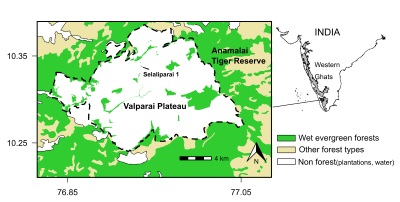 |
| Figure 2. Map of the Valparai plateau and the surrounding protected forests. (click for larger version) |
On 25 March 2016, at about 0610 h, a fresh (blood had not coagulated) road-kill of an otter was found by KS and PP near a forest fragment, Selaliparai 1 (10.337032 N, 76.934723 E, 1075 m asl), in the Valparai Plateau. The animal was killed on the main road passing through the adjoining tea plantation, at a spot that forms the shortest distance between two swamps. The stream closest to this spot flows through the 4 ha rainforest fragment, Selaliparai 1 (Fig. 3). Photographs were taken on-site (Fig. 4, 5, 6, 7), examined by DM, and shared with experts A. Kumar, W. Duckworth and R. Timmins who confirmed its identification as an otter that was neither smooth-coated nor small-clawed otter. A small piece of tissue (tip of the tail) was collected for confirmation of species using molecular methods. Combining both the examination of the specimen, pictures and analysis of the tissue sample of the specimen, it was with a high certainty identified to be a Eurasian otter Lutra lutra, a first record with evidence for this region.
Genetic Analysis
A fresh sample (about a cm of the tail tip) was collected using sterile surgical blade and stored in ethanol. This was sent to the Laboratory for Conservation of Endangered Species (LaCONES) at the Centre for Cellular and Molecular Biology (CCMB), Hyderabad, and analysed immediately. Mitochondrial DNA is commonly used to identify sample tissues to species level (Vergara et al., 2014; Effenberger and Suchentrunk, 1999; Fernandes et al., 2008). DNA was extracted and a universal vertebrate mitochondrial cytochrome b marker (Verma and Singh, 2003) was used to identify species. Sequencing was done in triplicates in both the forward and reverse directions using ABI 3730xl. 329 bases of the cytochrome b sequence were generated from the otter sample (GenBank accession no. MF135247). This sequence showed 100-97% identity (100% coverage) with Lutra lutra (Eurasian otter) sequences already available in the GenBank database. The second and third closest matches were also members of Genus Lutra (Lutra nippon: 97% identity and Lutra sumatrana: 92% identity). Meanwhile, Lutrogale perspicillata showed 91-90% identity and Aonyx cinereus showed 89% identity to the sample sequence. Furthermore, a neighbour-joining tree, reconstructed using MEGA v5.05 with the above sequences showed that the sample was nested within the Lutra lutra clade (Fig. 8), confirming that the sample belonged to Eurasian otter.
This is the first photographic and molecular evidence of the Eurasian otter from the Western Ghats. Recently, the species was camera-trapped in the Satpura Tiger Reserve in Central India, a first for that region (Joshi et al., 2016). This species has been expected to occur in the southern Western Ghats, according to historic records. However, there has been no prior direct evidence for it apart from skins in museums where there is a chance of mislabelling the origin of the skin. The species is fairly widely distributed in the Himalayan region with recent camera trap records in Ladakh and Sikkim (Melissa Savage and Sunita Khatiwara, pers. comm) and the east coast of India (Conroy et al., 1998) and also in Sri Lanka (Prater, 1980). Records of Eurasian otters without evidence in the form of photographs and DNA should be treated with caution as it is extremely difficult to reliably identify sympatric species of otters from just indirect evidence.
Acknowledgements: We thank thAsian small-clawed otter photographed by a camera-trap set along a stream in Valparai, Western Ghats in 2010.e Tamil Nadu Forest Department for the permissions for research in this region; M. Ananda Kumar and Sriram for logistics support; Ajith Kumar, Rob Timmins and Will Duckworth for help with species identification, and T R Shankar Raman for suggestions on the manuscript.
REFERENCES
Conroy, J., Melisch, R., Chanin, P. (1998). The Distribution and Status of the Eurasian Otter (Lutra lutra) in Asia - a preliminary review. IUCN Otter Spec. Group Bull. 15(1): 15–30
Effenberger, S., Suchentrunk, F. (1999) RFLP analysis of the mitochondrial DNA of otters (Lutra lutra) from Europe—implications for conservation of a flagship species, Biological Conservation, 90 (3): 229–234
Fernandes, C.A., Ginja, C., Pereira, I., Tenreiro, R., Bruford, M.W., Santos-Reis, M. (2008). Species-specific mitochondrial DNA markers for identification of non-invasive samples from sympatric carnivores in the Iberian Peninsula. Conserv Genet 9: 68.
Hussain, S.A. (1999). Status of Otter Conservation in India. Envis Bulletin: Wildlife and Protected Areas, 2(2): 92–97.
Joshi, A., Tumsare, V.M., Nagar, A.K., Mishra, A.K., Pariwakam, M.P. (2016). Photographic records of Eurasian Otter Lutra lutra from the central Indian landscape. IUCN Otter Specialist Group Bull. 33(2): 73–78
Kumar, A., Pethiyagoda, R., Mudappa, D. (2004). Western Ghats and Sri Lanka. In R. A. Mittermeier, P. R. Gil, M. Hoffmann, J. Pilgrim, T. Brooks, C. G. Mittermeier, J. Lamoureux & G. A. B. da Fonseca (Eds) Hotspots revisited—Earth’s biologically richest and most endangered ecoregions, CEMEX, Mexico.Pages 152–157
Meena V. (2002). Otter poaching in Palni Hills. Zoos’ Print Journal 17(2): 696–698
Mudappa, D., Raman, T.R.S. (2007). Rainforest restoration and wildlife conservation on private lands in the Western Ghats. Pages 210 – 240 in Making Conservation Work. Edited by G. Shahabuddin & M. Rangarajan. Permanent Black, Ranikhet.
Pascal, J.P., Ramesh, B.R., De Franceschi, D. (2004). Wet evergreen forest types of the southern western ghats, India Tropical Ecology, 45(2): 281–292
Pocock, R. I. (1941). The fauna of British India including Ceylon and Burma. Vol. II. Taylor and Francis,
Prakash, N., Mudappa, D., Raman, T.R.S., Kumar, A. (2012). Conservation of the Asian small-clawed otter (Aonyx cinereus) in human-modified landscapes, Western Ghats, India. Tropical Conservation Science 5: 67-78.
Prater, S. (1980). The Book of Indian Animals. Bombay Natural History Society, India.
Raha, A., Hussain, S.A. (2015). Factors affecting habitat selection by three sympatric otter species in the southern Western Ghats, India. Acta Ecologica Sinica, 36(1): 45-49
Sridhar, H., Raman, T.R.S., Mudappa, D. (2008). Mammal persistence and abundance in tropical rainforest remnants in the southern Western Ghats, India. Current Science 94: 748–757.
Umapathy, G., Durairaj, G. (1995). Preliminary Studies on the Feeding Ecology of the Otter Lutra lutra at Pitchavaram, East Coast of India. IUCN Otter Spec. Group Bull.11:24-26
Umapathy, G. (2000). Food Habits and Activity Pattern of the Common Otter Lutra Lutra Nair (F. Cuvier) At Pichavaram, Tamil Nadu, South India. Journal of Bombay Natural History Society, 97: 367–69
Vergara, M., Ruiz-Gonzalez, A., de Luzuriaga, J.L., Gomez-Moliner, B.J. (2014). Individual identification and distribution assessment of otters (Lutra lutra) through non-invasive genetic sampling: Recovery of an endangered species in the Basque Country (Northern Spain), Mammalian Biology - Zeitschrift für Säugetierkunde, 79(4): 259–267
Verma, S.K., Singh, L. (2003). Novel universal primers establish identity of an enormous number of animal species for forensic application. Molecular Ecology Notes, 3(1): 28–31.
Résumé : Premières Observations de la Loutre Eurasienne, Lutra lutra, dans les Collines d’Anamalai, dans les Ghats du Sud-Ouest, en Inde
Il existe des données historiques sur la loutre eurasienne dans le pic de biodiversité des Ghats de l’ouest, mais pas preuve durant ces 70 dernières années. Ceci a induit certains doutes concernant la fiabilité des données antérieures ou l’étiquetage erroné des individus. Cependant, depuis la découverte récente d’un accident de la route d’une loutre eurasienne et la confirmation de l’identité de l’espèce par des photos et des analyses moléculaires, la présence de l’espèce dans les collines d’Anamalia des Ghats du sud-ouest a été confirmée.
Dans cette note, nous présentons les premières données photographiques et moléculaires évidentes concernant la loutre eurasienne dans les Ghats du sud-ouest. Les mesures morphométriques enregistrées constituent une aide à l’identification de l’espèce et les échantillons de tissus analysés montrent une correspondance de 97 à 100 % avec les séquences de Lutra lutra disponibles dans la base de données GenBank. Les enregistrements basés sur des observations ou des indices sans preuve photographique ou moléculaire doivent être examinés avec prudence vu la difficulté d’identifier les loutres sur le terrain
Revenez au dessus
Resumen: Primer Registro dela Nutria Eurasiática Lutra Lutra en las Colinas Anamalai, Ghats Sudoccidentales, India
Ha habido registros históricos de nutria eurasiática en el hotspot de biodiversidad de los Ghats Sudoccidentales, pero no durante las siete décadas desde entonces. Esto ha llevado a tener dudas sobre la veracidad de aquellos registros anteriores, ó atribuirlos a un error en el etiquetado de especímenes. Sin embargo, con el reciente descubrimiento de una nutria eurasiática muerta en una ruta y la subsiguiente confirmación de la identidad de la especie, tanto a partir de fotografías como de análisis molecular, la ocurrencia de esta especie en las colinas Anamalai, de los Ghats Sudoccidentales, está confirmada. En esta nota, presentamos datos de esta primera evidencia fotográfica y molecular. Las mediciones morfométricas registradas ayudan a identificar a la especie, y la muestra de tejido analizada mostró una identida de 97-100% con secuencias de Lutra lutra disponibles en la base de datos GenBank. Los registros basados en avistajes ó signos sin evidencia fotográfica ó molecular deberían ser tratados con precaución, dada la dificultad de identificar a las nutrias en el campo
Vuelva a la tapa
